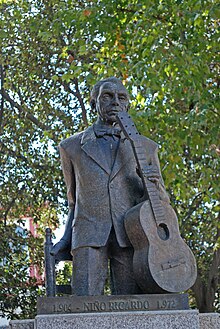Niño Ricardo
| Manuel Serrapí Sánchez | |
|---|---|

Statue of "Niño Ricardo", flamenco guitarist. Plaza del Cristo de Burgos in Sevilla
|
|
| Background information | |
| Also known as | Niño Ricardo |
| Born | July 11, 1904 Sevilla, |
| Died | 1972 |
| Genres | Flamenco |
| Occupation(s) | Flamenco guitarist |
| Instruments | flamenco guitar |
Niño Ricardo (11 July 1904 – 14 April 1972), born as Manuel Serrapí, was a Flamenco composer, considered by some sources as the most accomplished flamenco player of his day. He played a significant part in the evolution of the flamenco guitar. He lived in the city center of Sevilla. A child guitar prodigy, his early audiences referred to him as the son of Ricardo, leading to his stage-name Niño [de] Ricardo.
He was born on July 11, 1904, on Almudena Street of the Plaza de Argüelles in Seville (today Plaza del Cristo de Burgos), in Spain, in a typical neighborhood at that time. Today visitors contemplate the facade of the hotel which is dedicated to Niño Ricardo with a commemorative plaque.
Serrapí Ricardo Torres, guitarist and father of Niño Ricardo along with Antonio Moreno, a friend of the father, taught and introduced young Ricardo to the world of flamenco when he was 13 years old. Like his father, he did not want to play professionally.
Javier Molina, guitarist born in Jerez, was the one who gave the first opportunity to Niño Ricardo, at 14 years of age, to perform in a flamenco show, where he met singers whom he later accompanied both in Spain and beyond, and concert performance continued uninterrupted for the rest of his life. His career began in 1924 by accompanying La Niña de los Peines and at the age of 20 he began recording on his own.
His fingernails grew in a peculiar upward curve, a fact that influenced his playing style and tone. After a throat operation in 1945, he acquired a deep, raspy voice that is audible on recordings in which he hums along and offers encouraging remarks to the singer.
His bright chord arrangements with the left hand together with his creative genius made for his own unique falsetas (improvisations). His right hand was unique in its constant manipulation of the strings and insistent rhythmic counterpoint. The Ricardo touch carried such musical motivation that many singers acknowledged they never sang better than with his accompaniment. He also loved accompaniment and was fond of singing before a concert with his guitar and because he sang to his guitar, he encouraged others to join in..
He was one of the wisest players in flamenco history, and gave each song form its rightful place. He claimed that the guitar was his religion. He said the guitar with singing, should carry on a dialogue: "Neither should the singing silence the guitar nor the guitar obscure the passage of the cante (singing)". Flamenco guitar would not be what it is, if it were not for the Master.. The totally new style he developed revolutionized the guitar, creating a school called the 'Ricardismo' (very much Ricardo). He introduced a new challenge to the art of flamenco guitar playing at the time.
Ricardo was influenced by fellow flamenco players, including: Pinto, Torre, El Niño Gloria, Escacena, and Antonio Mairena. He spent his early years playing in the taverns and bars of Seville where he developed his own personal style and created much of his own material. He was inspired by the great threesome of flamenco guitar; Ramón Montoya, Manolo de Huelva, and Javier Molina, by whom he was guided at the start of his professional career in the Salon Variedades in Seville. Ricardo recorded with many singers, including Pastora, El Carbonerillo, Mazaco, Antonio and Manuel Mairena, Fernanda y Bernarda, Caracol and Talega.
...
Wikipedia
